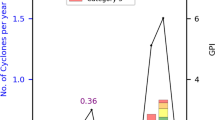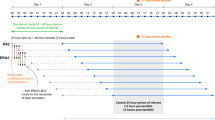Abstract
Tropical cyclone genesis potential index (GPI) is a useful metric for gauging the performance of global climate models in the simulation of tropical cyclone (TC) genesis. The performance of LASG/IAP AGCM GAMIL2.0 in the simulation of GPI over the western North Pacific (WNP) is assessed in this paper. Since GPI depends on large scale environmental factors including low-level vorticity at 850 hPa, relative humidity at 700 hPa, vertical wind shear between 850 and 200 hPa, maximum potential intensity (MPI), and vertical velocity, the bias of GPI simulation is discussed from the perspective of thermal and dynamical factors. The results are compared with the ECMWF reanalysis data (ERA40). The analyses show that both the climatological spatial pattern and seasonal cycle of GPI over the WNP are reasonably simulated by GAMIL2.0, but due to the overestimation of relative humidity, the simulated GPI extends to 170°E, about 10° east to that in the reanalysis data. It is demonstrated that the bias in the simulation of monsoon trough, which is about 5° north to the reanalysis, leads to an overestimation of GPI during May–June and September–October, but an underestimation during July–August. Over the WNP, the response of GPI to ENSO is well captured by GAMIL2.0, including the eastward (westward) shift of TC genesis location during El Niño (La Niña) years. However, the anomalous convective center associated with El Niño shifts westward about 20° in comparison to ERA40, which leads to the biases in both vertical velocity and relative humidity. These eventually result in the westward deflection of the boundary between the positive and negative GPI centers along 20°-30°N. The results from this study provide useful clues for the future improvement of GAMIL2.0.
Similar content being viewed by others
References
Barnston, A. G., M. Chelliah, and S. B. Goldenberg, 1997: Documentation of a highly ENSO-related SST region in the equatorial Pacific. Atmos. -Ocean, 35, 367–383.
Bell, G., M. Halpert, R. Schnell, et al., 2000: Climate assessment for 1999. Bull. Amer. Meteor. Soc., 81, S50–S51.
Camargo, S., and A. Sobel, 2005: Western North Pacific tropical cyclone intensity and ENSO. J. Climate, 18, 2996–3006.
—, K. Emanuel, and A. Sobel, 2007a: Use of a genesis potential index to diagnose ENSO effects on tropical cyclone genesis. J. Climate, 20, 4819–4834.
—, A. Sobel, A. Barnston, et al., 2007b: Tropical cyclone genesis potential index in climate models. Tellus, 59A, 428–443.
—, M. Wheeler, and A. Sobel, 2009: Diagnosis of the MJO modulation of tropical cyclogenesis using an empirical index. J. Atmos. Sci., 66, 3061–3074.
Chan, J., 1985: Tropical cyclone activity in the Northwest Pacific in relation to the El Niño/Southern Oscillation phenomenon. Mon. Wea. Rev., 113, 599–606.
Chu, P.-S., 2004: ENSO and tropical cyclone activity. Hurricanes and Typhoons: Past, Present, and Potential. Murnane R. J., and K.-B. Liu, Eds., Columbia University Press, 297–332.
Emanuel, K., 1988: The maximum intensity of hurricanes. J. Atmos. Sci., 45, 1143–1155.
—, 1995: Sensitivity of tropical cyclones to surface exchange coefficients and a revised steady-state model incorporating eye dynamics. J. Atmos. Sci., 52, 3969–3976.
—, 2005: Increasing destructiveness of tropical cyclones over the past 30 years. Nature, 436, 686–688.
—, and D. Nolan, 2004: Tropical cyclone activity and global climate. Preprints, 26th Conf. on hurricanes and Tropical Meteorology, Miami, FL, Amer. Meteor. Soc., 240–241.
Gray, W., 1968: Global view of the origin of tropical disturbances and storms. Mon. Wea. Rev., 96, 699–700.
Goddard, L., and M. Dilley, 2005: El Niño: Catastrophe or opportunity? J. Climate, 18, 651–665.
Guo Zhun, Wu Chunqiang, Zhou Tianjun, et al., 2011: A comparison of cloud radiative forcings simulated by LASG/IAP and BCC atmospheric general circulation models. Chinese J. Atmos. Sci., 35, 739–752. (in Chinese)
Li, L., B. Wang, and T. Zhou, 2007: Contributions of natural and anthropogenic forcings to the summer cooling over eastern China: An AGCM study. Geophys. Res. Lett., 34, K18807, doi:10.1029/2007GL030541.
—, —, Y. Yu, et al., 2010: Development and evaluation of GAMIL2.0 and FGOALS2.0-g. The 5th C20C Workshop, 25–28 October 2010, IAP, Beijing, 1–24.
Murakami, H., B. Wang, and A. Kitoh, 2011: Future change of western North Pacific typhoons: Projections by a 20-km-mesh global atmospheric model. J. Climate, 24, 1154–1169.
Nordeng, T. E., 1994: Extended versions of the convective parameterization scheme at ECMWF and their impact on the mean and transient activity of the model in the tropics. Tech. Memo., 206, ECMWF Shinfield Park, Reading, UK, 41 pp
Rayner, N., D. Parker, E. Horton, et al., 2003: Global analyses of SST, sea ice, and night marine air temperature since the late nineteenth century. J. Geophys. Res., 108, 4407.
Saffir, H., 2003: Communicating damage potentials and minimizing hurricane damage. Hurricane! Coping with Disaster. R. Simpson Ed., Washington, DC, American Geophysical Union, 155–164.
Uppala, S., W. Kallberg, A. Simmons, et al., 2005: The EAR-40 reanalysis. Quart. J. Roy. Meteor. Soc., 131, 2961–3012.
Unisys, 2011: Unisys weather hurricane tropical data. Available online at http://weather.unisys.com/hurricane/.
Yokoi, S., Y. Takayabu, and J. Chan, 2009: Tropical cyclone genesis frequency over the western North Pacific simulated in medium-range coupled general circulation models. Climate Dyn., 33, 665–683.
Zhang, Y., H. Wang, J. Sun, et al., 2009: Changes in the tropical cyclone genesis potential index over the western North Pacific in the SRES A2 scenario. Adv. Atmos. Sci., 27, 1246–1258.
Zhou, T., R. Yu, J. Zhang, et al., 2009a: Why the western Pacific subtropical high has extended westward since the late 1970s. J. Climate, 22, 2199–2215.
—, B. Wu, and B. Wang, 2009b: How well do atmospheric general circulation models capture the leading modes of the interannual variability of Asian-Australian monsoon? J. Climate, 22, 1159–1173.
—, —, A. Scaife, et al., 2009c: The CLIVAR C20C Project: Which components of the Asian-Australian monsoon circulation variations are forced and reproducible? Climate Dyn., 33, 1051–1068, doi: 10.1007/s00382-008-0501-8.
Author information
Authors and Affiliations
Corresponding author
Additional information
Supported by the National Basic Research and Development (973) Program of China (2010CB951904) and National Natural Science Foundation of China (41125017).
Chinese version to be published.
Rights and permissions
About this article
Cite this article
Tian, F., Zhou, T. & Zhang, L. Tropical cyclone genesis potential index over the western North Pacific simulated by LASG/IAP AGCM. Acta Meteorol Sin 27, 50–62 (2013). https://doi.org/10.1007/s13351-013-0106-y
Received:
Published:
Issue Date:
DOI: https://doi.org/10.1007/s13351-013-0106-y




